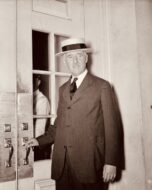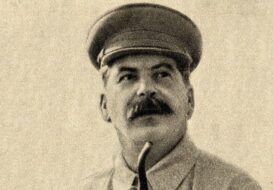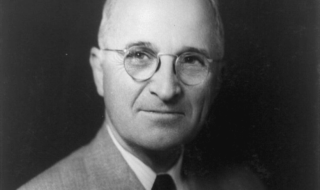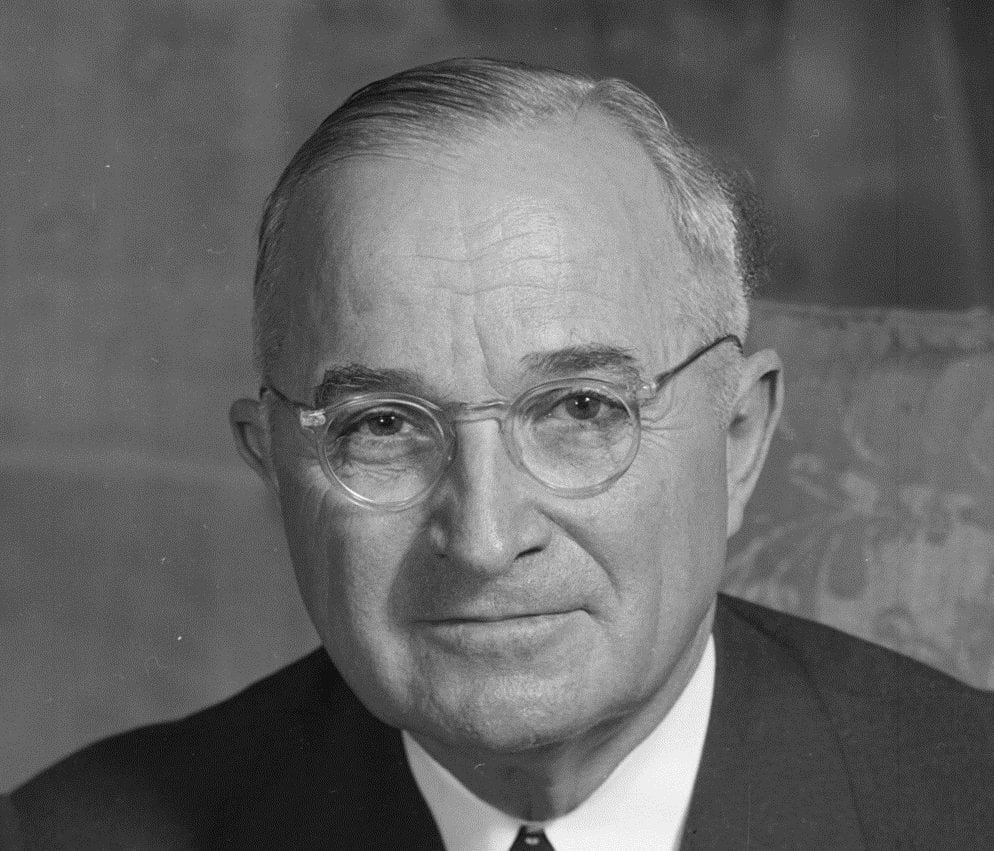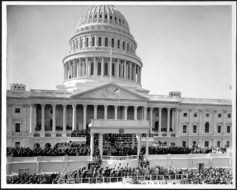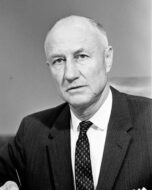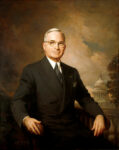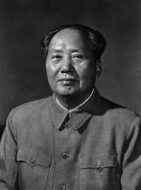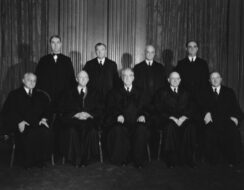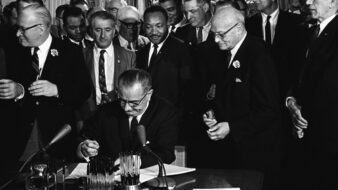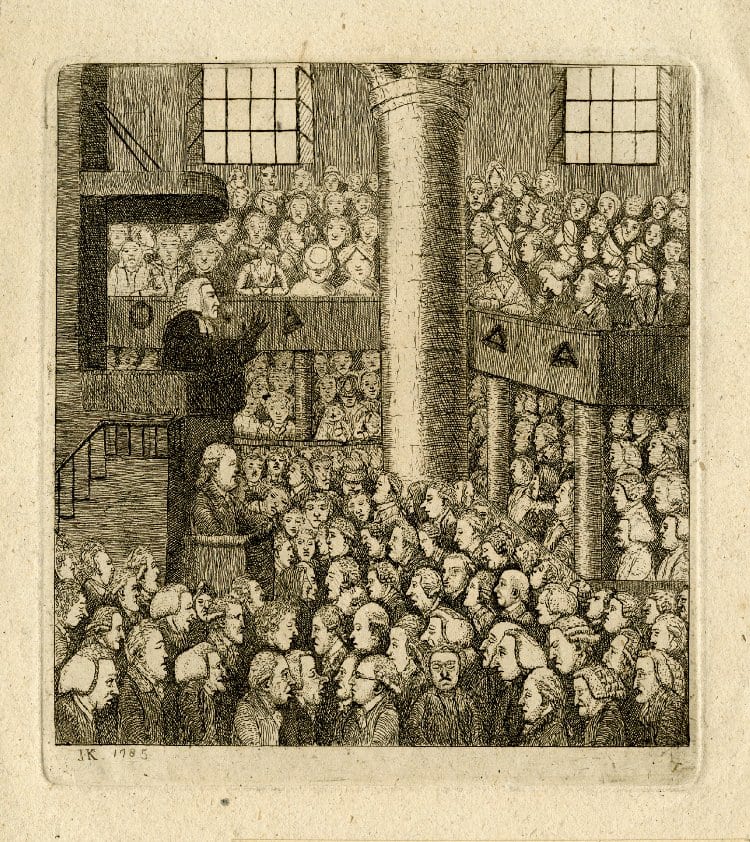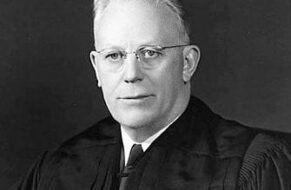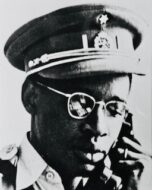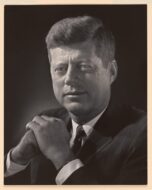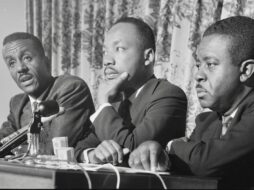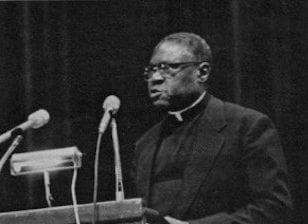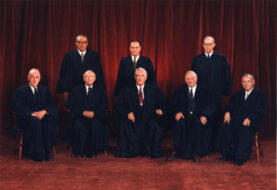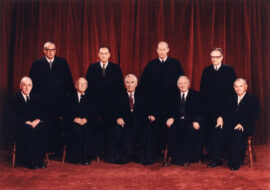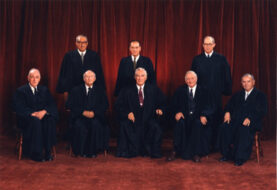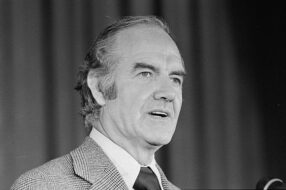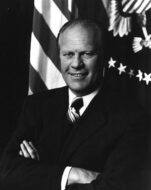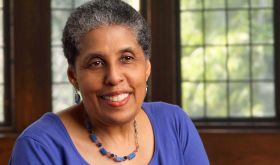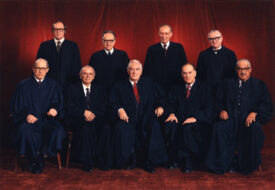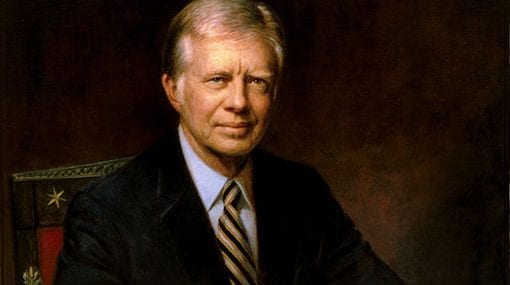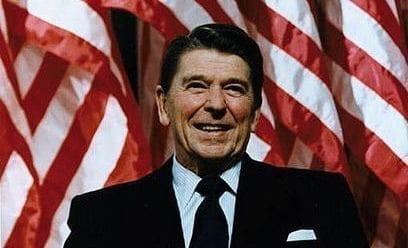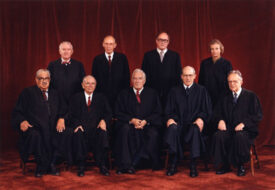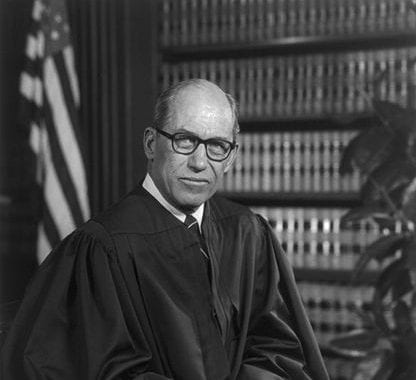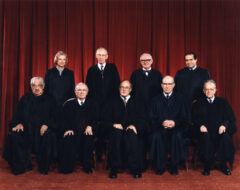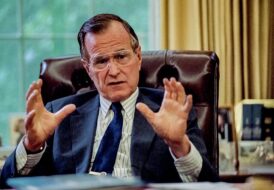


No related resources
Introduction
On June 6, 1966, James Meredith, an Air Force veteran and the first black American to attend the University of Mississippi, was one day into his solitary “March against Fear” when he was shot by a sniper just outside Hernando, Mississippi. Meredith had planned to march from Memphis to Jackson to encourage voter registration by black citizens in the Deep South. As he convalesced in a hospital, leaders of prominent black freedom organizations promised Meredith they would continue his effort. On June 16 they reached Greenwood, Mississippi, where Stokely Carmichael (1941–1998), the newly elected chairman of the Student Nonviolent Coordinating Committee (SNCC) (See Statement of Purpose), led participants in a rally, over Martin Luther King Jr.’s objection, in a chant: “We want Black Power!” The slogan caught on, especially among younger, more radicalized supporters and participants in the black freedom movement, and thenceforward the factional divisions in the movement deepened significantly.
Carmichael explained the fuller meaning of Black Power in the book excerpted here, coauthored with Columbia University political science professor Charles Hamilton.
Source: Stokely Carmichael (Kwame Ture) and Charles V. Hamilton, Black Power: The Politics of Liberation (New York: Vintage Books, 1967), 34–36, 37–38, 40, 41, 44–45, 46, 47, 50–51, 52–55. Black Power by Stokely Carmichael and Charles V. Hamilton, copyright © 1967 by Stokely Carmichael and Charles Hamilton. Used by permission of Random House, an imprint and division of Penguin Random House LLC. All rights reserved.
“To carve out a place for itself in the politico-social order,” V. O. Key Jr. wrote in Politics, Parties and Pressure Groups, “a new group may have to fight for reorientation of many of the values of the old order” (p. 57). This is especially true when that group is composed of black people in the American society—a society that has for centuries deliberately and systematically excluded them from political participation. Black people in the United States must raise hard questions, questions which challenge the very nature of the society itself: its long-standing values, beliefs, and institutions.
To do this, we must first redefine ourselves. Our basic need is to reclaim our history and our identity from what must be called cultural terrorism, from the depredation of self-justifying white guilt. We shall have to struggle for the right to create our own terms through which to define ourselves and our relationship to the society, and to have these terms recognized. This is the first necessity of a free people, and the first right that any oppressor must suspend.
In Politics among Nations, Hans Morgenthau defined political power as “the psychological control over the minds of men” (p. 29). This control includes the attempt by the oppressor to have his definitions, his historical descriptions, accepted by the oppressed. This was true in Africa no less than in the United States. To black Africans, the word “Uhuru” means “freedom,” but they had to fight the white colonizers for the right to use the term. The recorded history of this country’s dealings with red and black men offers other examples. In the wars between the white settlers and the Indians, a battle won by the cavalry was described as a victory. The Indians’ triumphs, however, were massacres. (The American colonists were not unaware of the need to define their acts in their own terms. They labeled their fight against England a “revolution”; the English attempted to demean it by calling it “insubordination” or “riotous.”)
The historical period following Reconstruction in the South after the Civil War has been called by many historians the period of Redemption, implying that the bigoted southern slave societies were “redeemed” from the hands of “reckless and irresponsible” black rulers. Professor John Hope Franklin’s Reconstruction or Dr. W. E. B. DuBois’ Black Reconstruction should be sufficient to dispel inaccurate historical notions, but the larger society persists in its own self-serving accounts. Thus black people came to be depicted as “lazy,” “apathetic,” “dumb,” “shiftless,” “good-timers.” Just as red men had to be recorded as “savages” to justify the white man’s theft of their land, so black men had to be vilified in order to justify their continued oppression. Those who have the right to define are the masters of the situation. Lewis Carroll understood this:
“When I use a word,” Humpty Dumpty said in a rather scornful tone, “it means just what I choose it to mean—neither more nor less.”
“The question is,” said Alice, “whether you can make words mean so many different things.”
“The question is,” said Humpty Dumpty, “which is to be master— that’s all.”. . .
Black people must redefine themselves, and only they can do that. Throughout this country, vast segments of the black communities are beginning to recognize the need to assert their own definitions, to reclaim their history, their culture; to create their own sense of community and togetherness. . . . When we begin to define our own image, the stereotypes—that is, lies—that our oppressor has developed will begin in the white community and end there. The black community will have a positive image of itself that it has created. This means we will no longer call ourselves lazy, apathetic, dumb, good-timers, shiftless, etc. Those are words used by white America to define us. If we accept these adjectives, as some of us have in the past, then we see ourselves only in a negative way, precisely the way white America wants us to see ourselves. Our incentive is broken and our will to fight is surrendered. From now on we shall view ourselves as African Americans and as black people who are in fact energetic, determined, intelligent, beautiful, and peace-loving. . . .
The values of this society support a racist system; we find it incongruous to ask black people to adopt and support most of those values. We also reject the assumption that the basic institutions of this society must be preserved. The goal of black people must not be to assimilate into middle-class America, for that class—as a whole—is without a viable conscience as regards humanity. The values of the middle class permit the perpetuation of the ravages of the black community. The values of that class are based on material aggrandizement, not the expansion of humanity. The values of that class ultimately support cloistered little closed societies tucked away neatly in tree-lined suburbia. The values of that class do not lead to the creation of an open society. That class mouths its preference for a free, competitive society, while at the same time forcefully and even viciously denying to black people as a group the opportunity to compete. . . .
. . .[T]his same middle class manifests a sense of superior group position in regard to race. This class wants “good government” for themselves; it wants good schools for its children. At the same time, many of its members sneak into the black community by day, exploit it, and take the money home to their middle-class communities at night to support their operas and art galleries and comfortable homes. When not actually robbing, they will fight off the handful of more affluent black people who seek to move in; when they approve or even seek token integration, it applies only to black people like themselves—as “white” as possible. This class is the backbone of institutional racism in this country.
Thus we reject the goal of assimilation into middle-class America because the values of that class are in themselves anti-humanist and because that class as a social force perpetuates racism. We must face the fact that, in the past, what we have called the movement has not really questioned the middle-class values and institutions of this country. If anything, it has accepted those values and institutions without fully realizing their racist nature. Reorientation means an emphasis on the dignity of man, not on the sanctity of property. It means the creation of a society where human misery and poverty are repugnant to that society, not an indication of laziness or lack of initiative. The creation of new values means the establishment of a society based, as Killens expresses it in Black Man’s Burden, on “free people,” not “free enterprise” (p. 167). To do this means to modernize—indeed, to civilize—this country. . . .
The concept of Black Power rests on a fundamental premise: Before a group can enter the open society, it must first close ranks. By this we mean that group solidarity is necessary before a group can operate effectively from a bargaining position of strength in a pluralistic society. Traditionally, each new ethnic group in this society has found the route to social and political viability through the organization of its own institutions with which to represent its needs within the larger society. Studies in voting behavior specifically, and political behavior generally, have made it clear that politically the American pot has not melted. Italians vote for Rubino over O’Brien; Irish for Murphy over Goldberg, etc. This phenomenon may seem distasteful to some, but it has been and remains today a central fact of the American political system. . . .
The point is obvious: black people must lead and run their own organizations. Only black people can convey the revolutionary idea—and it is a revolutionary idea—that black people are able to do things themselves. Only they can help create in the community an aroused and continuing black consciousness that will provide the basis for political strength. In the past, white allies have often furthered white supremacy without the whites involved realizing it, or even wanting to do so. Black people must come together and do things for themselves. They must achieve self-identity and self-determination in order to have their daily needs met.
Black Power means, for example, that in Lowndes County, Alabama, a black sheriff can end police brutality. A black tax assessor and tax collector and county board of revenue can lay, collect, and channel tax monies for the building of better roads and schools serving black people. In such areas as Lowndes, where black people have a majority, they will attempt to use power to exercise control. This is what they seek: control. When black people lack a majority, Black Power means proper representation and sharing of control. It means the creation of power bases, of strength, from which black people can press to change local or nationwide patterns of oppression—instead of from weakness. . . .
Black Power recognizes—it must recognize—the ethnic basis of American politics as well as the power-oriented nature of American politics. Black Power therefore calls for black people to consolidate behind their own, so that they can bargain from a position of strength. But while we endorse the procedure of group solidarity and identity for the purpose of attaining certain goals in the body politic, this does not mean that black people should strive for the same kind of rewards (i.e., end results) obtained by the white society. The ultimate values and goals are not domination or exploitation of other groups, but rather an effective share in the total power of the society.
Nevertheless, some observers have labeled those who advocate Black Power as racists; they have said that the call for self-identification and self-determination is “racism in reverse” or “black supremacy.” This is a deliberate and absurd lie. There is no analogy—by any stretch of definition or imagination—between the advocates of Black Power and white racists. Racism is not merely exclusion on the basis of race but exclusion for the purpose of subjugating or maintaining subjugation. The goal of the racists is to keep black people on the bottom, arbitrarily and dictatorially, as they have done in this country for over three hundred years. The goal of black self-determination and black selfidentity—Black Power—is full participation in the decisionmaking processes affecting the lives of black people, and recognition of the virtues in themselves as black people. . . .
. . .The advocates of Black Power reject the old slogans and meaningless rhetoric of previous years in the civil rights struggle. The language of yesterday is indeed irrelevant: progress, nonviolence, integration, fear of “white backlash,” coalition. Let us look at the rhetoric and see why these terms must be set aside or redefined.
One of the tragedies of the struggle against racism is that up to this point there has been no national organization which could speak to the growing militancy of young black people in the urban ghettos and the Black Belt South. There has been only a “civil rights” movement, whose tone of voice was adapted to an audience of middleclass whites. It served as a sort of buffer zone between that audience and angry young blacks. It claimed to speak for the needs of a community, but it did not speak in the tone of that community. None of its so-called leaders could go into a rioting community and be listened to. In a sense, the blame must be shared—along with the mass media—by those leaders for what happened in Watts, Harlem, Chicago, Cleveland, and other places. Each time the black people in those cities saw Dr. Martin Luther King get slapped they became angry. When they saw little black girls bombed to death in a church and civil rights workers ambushed and murdered, they were angrier; and when nothing happened, they were steaming mad. We had nothing to offer that they could see, except to go out and be beaten again. We helped to build their frustration.
We had only the old language of love and suffering. And in most places— that is, from the liberals and middle class—we got back the old language of patience and progress. . . .“Progress is being made,” we were told. . . .
. . .The black community was told time and again how other immigrants finally won acceptance: that is, by following the Protestant Ethic of Work and Achievement. They worked hard; therefore, they achieved. We were not told that it was by building Irish Power, Italian Power, Polish Power, or Jewish Power that these groups got themselves together and operated from positions of strength. We were not told that “the American dream” wasn’t designed for black people. That while today, to whites, the dream may seem to include black people, it cannot do so by the very nature of this nation’s political and economic system, which imposes institutional racism on the black masses if not upon every individual black. . . .
When the concept of Black Power is set forth, many people immediately conjure up notions of violence. The country’s reaction to the Deacons for defense and Justice,1 which originated in Louisiana, is instructive. Here is a group which realized that the “law” and law enforcement agencies would not protect people, so they had to do it themselves. If a nation fails to protect its citizens, then that nation cannot condemn those who take up the task themselves. The Deacons and all other blacks who resort to selfdefense represent a simple answer to a simple question: what man would not defend his family and home from attack? . . . .
. . .Those of us who advocate Black Power are quite clear in our own minds that a “nonviolent” approach to civil rights is an approach black people cannot afford and a luxury white people do not deserve. It is crystal clear to us—and it must become so with the white society—that there can be no social order without social justice. . . .
Next, we must deal with the term “integration.” According to its advocates, social justice will be accomplished by “integrating the Negro into the mainstream institutions of the society from which he has been traditionally excluded.” This concept is based on the assumption that there is nothing of value in the black community and that little of value could be created among black people. The thing to do is siphon off the “acceptable” black people into the surrounding middle-class white community.
The goals of integrationists are middle-class goals, articulated primarily by a small group of Negroes with middleclass aspirations or status. Their kind of integration has meant that a few blacks “make it,” leaving the black community, sapping it of leadership potential and know-how. As we noted in Chapter 1, those token Negroes—absorbed into a white mass—are of no value to the remaining black masses. They become meaningless show-pieces for a conscience-soothed white society. Such people will state that they would prefer to be treated “only as individuals, not as Negroes”; that they “are not and should not be preoccupied with race.” This is a totally unrealistic position. In the first place, black people have not suffered as individuals but as members of a group; therefore, their liberation lies in group action. This is why SNCC—and the concept of Black Power—affirms that helping individual black people to solve their problems on an individual basis does little to alleviate the mass of black people. Secondly, while color-blindness may be a sound goal ultimately, we must realize that race is an overwhelming fact of life in this historical period. There is no black man in this country who can live “simply as a man.” His blackness is an ever-present fact of this racist society, whether he recognizes it or not. It is unlikely that this or the next generation will witness the time when race will no longer be relevant in the conduct of public affairs and in public policy decision-making. To realize this and to attempt to deal with it does not make one a racist or overly preoccupied with race; it puts one in the forefront of a significant struggle. If there is no intense struggle today, there will be no meaningful results tomorrow.
“Integration” as a goal today speaks to the problem of blackness not only in an unrealistic way but also in a despicable way. It is based on complete acceptance of the fact that in order to have a decent house or education, black people must move into a white neighborhood or send their children to a white school. This reinforces, among both black and white, the idea that “white” is automatically superior and “black” is by definition inferior. For this reason, “integration” is a subterfuge for the maintenance of white supremacy. It allows the nation to focus on a handful of southern black children who get into white schools at a great price, and to ignore the 94 percent who are left in unimproved all-black schools. Such situations will not change until black people become equal in a way that means something, and integration ceases to be a one-way street. Then integration does not mean draining skills and energies from the black ghetto into white neighborhoods. To sprinkle black children among white pupils in outlying schools is at best a stop-gap measure. The goal is not to take black children out of the black community and expose them to white middle-class values; the goal is to build and strengthen the black community.
“Integration” also means that black people must give up their identity, deny their heritage. . . .The fact is that integration, as traditionally articulated, would abolish the black community. The fact is that what must be abolished is not the black community, but the dependent colonial status that has been inflicted upon it.
The racial and cultural personality of the black community must be preserved, and that community must win its freedom while preserving its cultural integrity. Integrity includes a pride—in the sense of self-acceptance, not chauvinism—in being black, in the historical attainments and contributions of black people. No person can be healthy, complete, and mature if he must deny a part of himself; this is what “integration” has required thus far. This is the essential difference between integration as it is currently practiced and the concept of Black Power.
- 1. A self-defense group established in 1964.

Conversation-based seminars for collegial PD, one-day and multi-day seminars, graduate credit seminars (MA degree), online and in-person.

